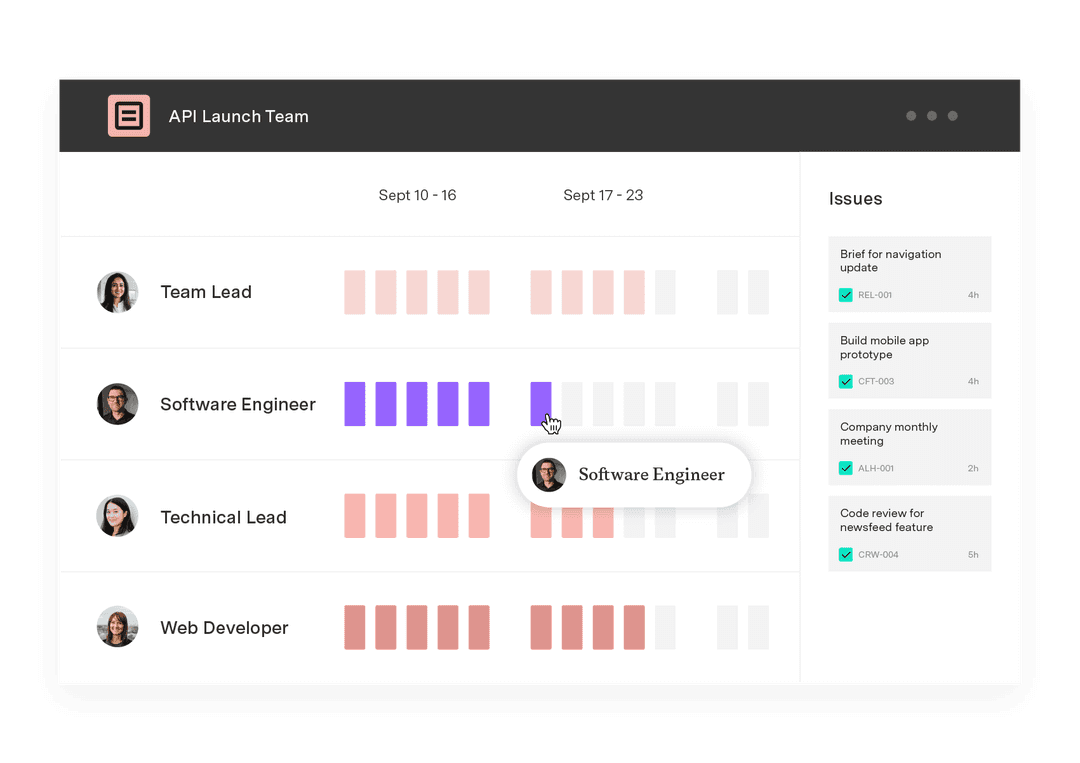What is MOCHA in project management? How to and why you should use it
Tempo Team
When project roles aren’t clear, even the best teams can end up spinning their wheels and missing key deadlines.
Imagine you’re three weeks away from your next product launch and realize your team is out of sync. Marketing is waiting on final specs from your engineering team, but engineering has no idea marketing is still waiting on them for anything. Meanwhile, your biggest stakeholder is trying to get the budget numbers from finance, and your finance team is reporting different numbers from the ones your project lead laid out.
This is where MOCHA project management comes in. This framework removes the guesswork from your project planning processes and creates clear responsibilities within your teams and organization. Let’s explore what MOCHA is, how to use it effectively, and why it matters for businesses like yours.
What is MOCHA in project management?
MOCHA is a simple framework that reduces project confusion by giving everyone involved a clear role. Using MOCHA, you assign five specific jobs to every project task: Manager, Owner, Consultant, Helper, and Approver.
This responsibility assignment matrix, created by the Management Center, builds on older, classic project management concepts like RACI (Responsible, Accountable, Consulted, Informed), but many teams find that MOCHA is more flexible and practical for real-world projects.
One key difference between the models is that while RACI lumps management and ownership into one category, the MOCHA framework separates these into two distinct roles. Plus, MOCHA adds a dedicated “Helper” role, so you know who’s responsible for stepping in to help with the hands-on tasks.
With MOCHA project management, you define upfront who’s in charge of running the project, delivering key outcomes, being your subject matter expert, executing tasks, and giving final approval. When everyone understands their role, you see fewer issues with teams stepping on each other’s toes, and less work falls through the cracks.
What does MOCHA stand for?
To get the most from the MOCHA framework, you need a deeper understanding of each letter and the role it represents.
M is for Manager
The Manager oversees how work gets done and is responsible for keeping the Owner on track. This role asks the tough questions, offers guidance or advice if things get stuck, and waits to step in if things really go off the rails.
The goal is to keep the Manager from becoming a micromanager. All they need to do is remove obstacles, and they shouldn’t have to tell people what to do with every task on their plate.
O is for Owner
The Owner is responsible for delivering the project. They coordinate resources, make day-to-day decisions, and make sure everything gets done. Ultimately, whether the project succeeds or fails is up to the Owner.
Every project needs just one Owner. Having multiple Owners might lead to finger-pointing and confusion, so choose one person carefully.
C is for Consulted
Think of your Consulted person as your subject matter expert. This is the team member you bring in for expertise and advice as needed. Depending on the project, they might be someone with experience in similar projects or a fresh outside perspective.
H is for Helper
Helpers execute a majority of the project work. They work closely with the Owner to complete assigned tasks, report progress, and flag any issues before they become major roadblocks. Unlike the Owner role, you don’t need just one Helper on the project. Depending on the project and organization size, the Helper might even manage their own sub-team of additional Helpers.
A is for Approver
The Approver is the person with the power to make the final call on major decisions. Budgets, strategic direction, and other go-or-no-go moments in the project fall to the Approver. These team members are often major stakeholders or executives.
When to use MOCHA in project management
No approach or framework is right for every scenario. Let’s take a look at some of the situations and project types where the MOCHA framework really shines.
Complex projects with multiple stakeholders
When a project involves multiple departments, external vendors, and other stakeholders, things get complicated. Without clear team roles and responsibilities, everyone on the project might assume someone else is handling one critical piece – all while three people tackle the same task somewhere else in the project.
MOCHA prevents these challenges by creating clear accountability chains. Consider a major software implementation that involves multiple business units. With the MOCHA project management method, every department knows who owns the project, who approves changes, and who steps in with technical expertise or decision-making authority when challenges arise.
Major project delegation
Without the right project management framework, handing off a major project is a recipe for disaster. The person taking ownership needs to understand not just what they’re responsible for, but who can help them and who they report to. MOCHA is a natural fit for this scenario because it clarifies every role right off the bat.
Decision-making authority
Nothing halts a project faster than decisions stuck in limbo. When multiple people feel they should have the final say – or when no one wants to step up and take charge – goals and objectives grind to a halt.
MOCHA’s responsibility assignment matrix separates the people who weigh in with advice and the people responsible for a final “yes” or “no.” Marketing campaigns are great candidates for this approach because they need creative approval, budget sign-off, and compliance review from different stakeholders, but someone still needs to give the green light that kicks off the work.
During cross-functional collaboration
When engineering, design, marketing, and sales all need to work together, communication issues are bound to happen. Each team has its own priorities and ways of working, which creates conflict.
MOCHA streamlines these projects by guiding how departments interact, giving everyone a shared process and playbook so they don’t have to fight for control.
5 benefits of using MOCHA in project management
Here’s what you can expect when you implement this approach:
1. Reduce confusion
MOCHA creates explicit team roles and responsibilities so everyone knows what they’re accountable for, who they can ask for help, and where their responsibilities end. The result is fewer conflicts between team members and faster task completion because there’s no confusion about who’s doing what by when.
2. Empower project owners
Some project managers feel like they’re set up to fail: They’re held accountable for the project's results, but they don’t have the authority to do it the way it needs to be done. MOCHA empowers the Owner to own the project while giving them the Helper and Consulted resources they need to succeed.
3. Improve accountability
When no one knows who’s in charge, work, results, and deadlines all fall through the cracks. With MOCHA project management, there’s no room for finger-pointing or hiding behind vague job descriptions. The clarity of this project management framework enhances accountability, meaning more work gets done.
4. Streamline communication and decision-making
MOCHA maps out the information flow and decision hierarchy at the project outset. From day one, team members know who needs status updates, who to call on for expertise, and who gives final approval. This eliminates the information bottlenecks that kill project momentum.
5. Scale with project complexity
Some project management models fall apart as projects and organizations grow. MOCHA scales where other models don’t because of the cascading nature of its roles. Helpers can become Owners of their own sub-projects, managing smaller teams tackling parts of the larger project in their own MOCHA framework. This approach clarifies every detail, no matter how large or complex the project gets.
Clarifying roles and responsibilities with Tempo
If you want to make this approach work in practice, you need the right project management tools. That’s where Tempo comes in.
MOCHA defines who does what, and Tempo shows you how it’s actually working. Capacity Planner clarifies role assignments before you pull the trigger, and Tempo Timesheets improves your processes by tracking where time actually goes. This makes it easier to optimize your efforts for the next project.
Ready to put MOCHA into action? Try Tempo today.













































